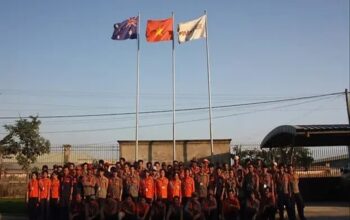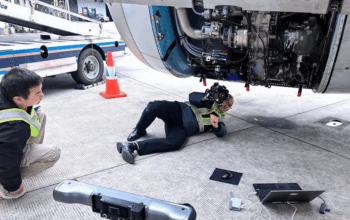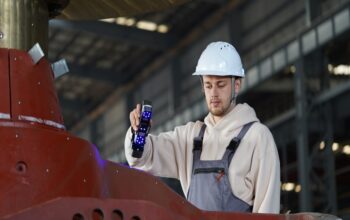This content was originally written and published by the Nikon Metrology team on their website. Reproduced here from https://blog.nikonmetrology.com/new-apdis-laser-radar/
Nikon Metrology’s Laser Radar has been at the forefront of a quiet revolution in automotive quality control, bringing high accuracy, absolute measurements to the shop floor. With over 150 installations in 36 vehicle plants worldwide, the Laser Radar has proved itself to be an invaluable tool for manufacturers to improve their quality, reduce scrap, and ultimately save money.
The release of the new APDIS Laser Radar builds on this success to give the most productive Laser Radar ever built. This will drive the changes required for an automotive industry that has for many years been striving to achieve better productivity and higher overall quality.

Traditional metrology has its drawbacks
The Holy Grail in a car plant is to be able to control manufacturing quality within a production line to the accuracy for which the twin-horizontal-arm CMM is renowned. Despite being the gold standard, it is difficult to install outside a controlled metrology laboratory and can struggle with access to certain areas of a car body, while certain features such as studs are difficult to measure without using adapters.
Another drawback is that it is very slow for comprehensive 100 percent inspection, even if touch probes are replaced by laser scanning heads. This means it can take a full shift to remove a car from the production line, move it to a dedicated metrology room, perform a measurement cycle, and then re-insert the car back into the production line, making it impractical for good process control.
During pre-launch builds where reliable, accurate data is essential for tuning in the process, these long inspection times cause delays in the build process and typically only a fraction of bodies can be measured in this way. The CMMs become a bottleneck for inspection and ramp-up to full production is slowed, costing time and money.
Currently, in-line inspection in car plants is typically performed by a flexible measuring system (FMS). It uses fixed or robot-mounted laser scanners requiring a sensor to be fitted for each feature to be measured, or multiple robot moves. The data acquired, although repeatable, is not in absolute coordinates, so a measured body-in-white (BiW) needs to be taken to a CMM room for the results to be correlated. This may have to be done 10 to 20 times during the initial set-up and thereafter once every two weeks, costing both money and time.
Other disadvantages of such robotic systems are that they require a lot of programming effort and are susceptible to drift over time. Furthermore, due to the short stand-off, the robot is close to the car body, risking collisions if errors occur which can cause rework, scrappage and line stoppage, with all their financial implications.
Enter the Laser Radar – the Holy Grail
Due to their absolute accuracy, long stand-off, speed of data acquisition and shop floor suitability, Nikon Metrology’s proprietary Laser Radar scanners mounted on multi-axis robots overcome the problems of CMM and FMS systems. They provide fast, accurate, absolute data on the shop floor and can be installed in fully automated measurement cells. It is a mature, safe, patented technology used for over seven years in automotive production, with currently more than 150 installations operating in 36 vehicle plants worldwide.
Depending on the OEM’s production volumes and the number of features to be investigated, the technology can either cope with 100 percent in-line inspection or by-pass inspection of samples close to the line. It enables true process control on the factory floor, as short feedback loops to the line can automatically adjust production parameters to keep features within tolerance. Laser Radar is also used off-line to replace other metrology systems in dedicated inspection rooms.
Precise control over the scan path and accurate, point cloud-based feature measurements keep data sets small. Holes, slots, and other sheet metal features can each be measured in a few seconds and specific surface points at several per second. Combined with fast movements between features, it enables short measurement times to be achieved. Even traditionally troublesome features such as studs can be scanned and measured rapidly without the need for adapters.
A major automotive OEM that is using the previous generation of Nikon Metrology Laser Radar wanted to achieve faster ramp-up to higher quality much earlier in a line’s pre-build cycle as well as better overall process control. The objective was to achieve a high percentage of in-tolerance parts before the start of production. The target was in fact exceeded, a performance far better than during any previous launches. The company stated that integrating real-time feedback of absolute measurements into its Industry 4.0 production line resulted in an astonishing payback time for the Laser Radar system due to faster entry into full production. It also benefitted from raised ongoing metrology efficiency.
APDIS – The same but different
The arrival of the APDIS Laser Radar range further advances the technology. APDIS still takes absolute 3D surface measurements of an object using a mirror to move a focused infrared laser beam. Precision control and high sampling rates create optimized scan paths with minimal data sets from which surfaces and points are easily extracted, even from difficult-to-measure features such as studs and threaded holes inside a BiW.
APDIS provides a host of new features to better benefit automotive installations including up to double the measurement speed with the Enhanced version. A new, high definition camera coupled with new Nikon confocal optics allow for better viewing of what is being inspected. Usability has also been improved by reducing the unit’s weight by 40 percent and its size by a quarter, while internal changes and comprehensive testing have further raised the level of reliability, which now includes IP54 protection against dust and water ingress.
Compared to CMM measurements, APDIS is able to complete inspection cycles in a fraction of the time, greatly increasing productivity and throughput, in certain cases by over 600 percent. Measurement variability is reduced through automation and non-contact measurement and is simplified through the use of standard software interfaces such as Metrolog, Polyworks, and Spatial Analyzer.
The APDIS range comprises four models, two of which are the MV430E and MV450E having a 30 meter or 50-meter radius measuring range respectively. These versions include Enhanced Feature Scan technology, offering up to double the feature measurement speed compared to previous Laser Radars, made possible by hardware and software improvements. These also allow Enhanced APDIS scanners to be used as a non-contact accelerometer by pointing the laser beam at any surface to measure vibrations to micron resolution at up to 2,000Hz, which can be useful when assessing installations or equipment.
There are also MV430 and MV450 Standard versions without the improvements for applications where top speed and vibration analysis are not required. Typical length measurement accuracies for all models range from 28 μm at 2 meters to 313 μm at 30 meters and the minimum range is now shorter at 0.5 meters.
The bottom line is that taking measurements in absolute coordinates using Nikon Metrology’s APDIS Laser Radar technology is ideal for integration into a digital manufacturing environment. It allows the advantages of Industry 4.0 and Quality 4.0 to be leveraged, with big data used to improve process control, facilitating better insight and decision making as well as speeding up product development.
To know more, please check Nikon.









